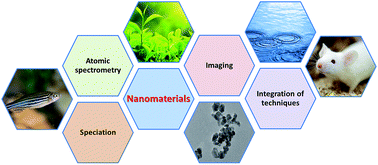当前位置:
X-MOL 学术
›
J. Anal. At. Spectrom.
›
论文详情
Our official English website, www.x-mol.net, welcomes your
feedback! (Note: you will need to create a separate account there.)
Current trends in atomic mass spectrometry for the speciation and imaging of metal-based nanomaterials
Journal of Analytical Atomic Spectrometry ( IF 3.1 ) Pub Date : 2017-08-11 00:00:00 , DOI: 10.1039/c7ja00188f Judy Tsz-Shan Lum 1, 2, 3, 4 , Kelvin Sze-Yin Leung 1, 2, 3, 4, 5
Journal of Analytical Atomic Spectrometry ( IF 3.1 ) Pub Date : 2017-08-11 00:00:00 , DOI: 10.1039/c7ja00188f Judy Tsz-Shan Lum 1, 2, 3, 4 , Kelvin Sze-Yin Leung 1, 2, 3, 4, 5
Affiliation

|
With the rapid development and growing number of applications of metal-based nanomaterials (metal-based NMs), it is of vital importance to evaluate their impact on both environmental and biological systems. The first step in assessing the impact is to determine exactly which metal-based NM species are where and in what quantities. Common approaches involve techniques like transmission electron microscopy (TEM) or scanning electron microscopy (SEM) for metal-based NM characterization and ICP-MS for total elemental analysis; however, these techniques cannot retrieve information pertaining to speciation, localization, or quantification of different metal-based NMs. This review summarizes approaches currently adopted for speciation and imaging of metal-based NMs, particularly in environmental systems. In response to the need to distinguish nanoparticles in the dissolved ionic fraction and/or distinguish them based on size, shape or coating for toxicity studies, more advanced methods and techniques are being developed. Various elemental imaging techniques are being used for the study of the localization of metal-based NMs within organisms as well as for speciation or quantification studies to evaluate the effects and influence of metal-based NMs on environmental and biological systems. It is envisioned that more complementary techniques (e.g. elemental and molecular techniques, mass spectroscopy and X-ray based techniques) will be employed to conduct quantitative analysis with imaging, speciation and elucidation, to better elucidate the fate and transformation of metal-based NMs. The results of these studies can provide valuable insights to understand the behavior and effect of metal-based NMs in different systems.
中文翻译:

原子质谱的当前趋势,用于金属基纳米材料的形成和成像
随着金属基纳米材料(金属基NMs)的快速发展和应用数量的增加,评估其对环境和生物系统的影响至关重要。评估影响的第一步是准确确定哪些金属基NM物种在何处以及数量。常见的方法包括透射电子显微镜(TEM)或扫描电子显微镜(SEM)用于基于金属的NM表征和ICP-MS用于总元素分析的技术。但是,这些技术无法检索与不同金属基NM的形态,定位或定量有关的信息。这篇综述总结了目前用于金属基NM的形成和成像的方法,特别是在环境系统中。响应于需要区分溶解的离子部分中的纳米颗粒和/或基于尺寸,形状或涂层来区分它们以进行毒性研究,正在开发更高级的方法和技术。各种元素成像技术正在用于研究生物体内金属基NM的定位以及物种形成或定量研究,以评估金属基NM对环境和生物系统的影响。可以预见,更多的补充技术(各种元素成像技术正在用于研究生物体内金属基NM的定位以及物种形成或定量研究,以评估金属基NM对环境和生物系统的影响。可以预见,更多的补充技术(各种元素成像技术正在用于研究生物体内金属基NM的定位以及物种形成或定量研究,以评估金属基NM对环境和生物系统的影响。可以预见,更多的补充技术((例如元素和分子技术,质谱和基于X射线的技术)将通过成像,物种形成和阐明进行定量分析,以更好地阐明金属基NM的命运和转变。这些研究的结果可以提供有价值的见解,以了解金属基NM在不同系统中的行为和效果。
更新日期:2017-11-02
中文翻译:

原子质谱的当前趋势,用于金属基纳米材料的形成和成像
随着金属基纳米材料(金属基NMs)的快速发展和应用数量的增加,评估其对环境和生物系统的影响至关重要。评估影响的第一步是准确确定哪些金属基NM物种在何处以及数量。常见的方法包括透射电子显微镜(TEM)或扫描电子显微镜(SEM)用于基于金属的NM表征和ICP-MS用于总元素分析的技术。但是,这些技术无法检索与不同金属基NM的形态,定位或定量有关的信息。这篇综述总结了目前用于金属基NM的形成和成像的方法,特别是在环境系统中。响应于需要区分溶解的离子部分中的纳米颗粒和/或基于尺寸,形状或涂层来区分它们以进行毒性研究,正在开发更高级的方法和技术。各种元素成像技术正在用于研究生物体内金属基NM的定位以及物种形成或定量研究,以评估金属基NM对环境和生物系统的影响。可以预见,更多的补充技术(各种元素成像技术正在用于研究生物体内金属基NM的定位以及物种形成或定量研究,以评估金属基NM对环境和生物系统的影响。可以预见,更多的补充技术(各种元素成像技术正在用于研究生物体内金属基NM的定位以及物种形成或定量研究,以评估金属基NM对环境和生物系统的影响。可以预见,更多的补充技术((例如元素和分子技术,质谱和基于X射线的技术)将通过成像,物种形成和阐明进行定量分析,以更好地阐明金属基NM的命运和转变。这些研究的结果可以提供有价值的见解,以了解金属基NM在不同系统中的行为和效果。











































 京公网安备 11010802027423号
京公网安备 11010802027423号